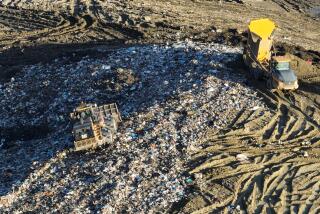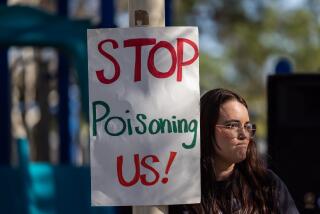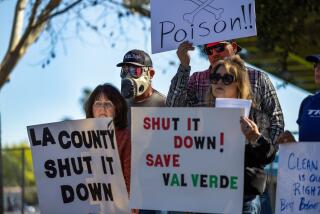Sides Debate Expansion of Toland Landfill
Expanding Toland Road Landfill would provide western Ventura County with a long-term trash solution that would benefit the local economy and guarantee local control.
That’s one side of the argument.
On the other hand, the county is required by law to significantly reduce trash flow to landfills before the end of the decade, and with a glut of available space in nearby Los Angeles County, there is no need to expand Toland.
That’s the other side.
Both sides of the debate got plenty of air time during a trash forum sponsored by the Ventura County Economic Development Assn. in Oxnard on Wednesday.
In one corner was Clint Whitney, general manager of Ventura Regional Sanitation District, which runs Toland.
In the other were county Supervisor Maggie Kildee and Fillmore City Councilman Roger Campbell, political rivals who also happen to be members of the Western Ventura County Waste Management Authority, which opposes the landfill expansion.
The longstanding issue over what to do with west county trash stems from the impending closure of Bailard Landfill in Oxnard. That dump, also run by the sanitation district, is scheduled to close within 18 months.
During Wednesday’s forum, Whitney argued that the most financially viable alternative is to enlarge Toland Road Landfill between Santa Paula and Fillmore. Toland is currently permitted to handle only 135 tons a day.
“If you take your waste to Sunshine Canyon or Chiquita Canyon [in Los Angeles County], you have nothing whatsoever to say about the price,” Whitney said. An expanded Toland landfill would probably be able to offer a tipping fee of $25 a ton or less, he said.
“We submit you’ll have a tough time finding any landfill outside this county that will meet that,” said Whitney, whose agency already has launched an environmental review of the proposed landfill expansion that is due in September.
*
But Campbell said that Whitney’s cost estimates are based on Toland Road receiving 1,500 tons of trash a day. With the county mandated by state law to reduce trash flow to landfills by 50% by the year 2000, the actual tonnage would probably be much lower, which means higher tipping fees, he said.
Moreover, Campbell said, there is little incentive to reduce trash flow with a publicly owned landfill, because the dump must pay for itself.
“If we reduce the tons, it becomes less profitable and prices go up,” he said.
Campbell and Kildee said that trash has become increasingly valuable in recent years as recycling technology is able to convert more items into commercial products. That increases the county’s leverage in dealing with recycling centers and landfills, they said.
“It’s no longer trash,” Campbell said. “It’s a commodity. There’s a lot of people out there who want it. That puts us in the driver’s seat.”
Although there is still a need for landfill space, Campbell and Kildee said there are enough disposal options available in Los Angeles County to ensure competitive prices.
*
“Within a 30-mile radius of Ventura County, there is room in existing landfills to dispose of 38 million tons of waste,” Kildee said. “At our current rate of disposal that could last until the end of the next decade.”
During Wednesday’s forum, Campbell, who is challenging Kildee for her job, took a swipe at the county waste commission she formed in 1989 for not resolving the trash issue sooner.
“The topic of my talk today is, ‘Trash, What a Waste,’ because that’s what’s been going on for the last few years,” he said. “The commission has not done anything. It has not accomplished one thing.”
But Kildee said the commission has served as a valuable forum for local officials from around the county to talk about trash issues.
She said it also led to the recent formation of the west county waste authority, which includes the county and the cities of Fillmore, Santa Paula, Ojai and Ventura. The authority was established to increase the bargaining power of the municipalities.
More to Read
Sign up for Essential California
The most important California stories and recommendations in your inbox every morning.
You may occasionally receive promotional content from the Los Angeles Times.










